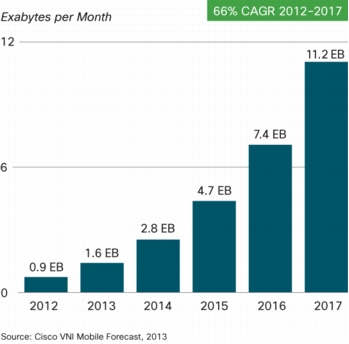Mobile Traffic Grew 70% In 2012

Mobile usage trends continue ever upward, and the latest data and forecasts from Cisco are staggering.
Mobile traffic is increasing very quickly, growing 70% in 2012. What applications are eating up all that data? Not surprisingly, mobile video streaming apps account for the largest percentage of data use. Video is now more than half of mobile data traffic, with “information” at 12%, social networking at 7%, web browsing at 6%, and music streaming at only 4%. With large amounts of video content now available for free, and with apps like Netflix offering access to content treasure troves for a low monthly price, users are turning away from traditional video sources and moving onto their devices, especially tablets, which go anywhere and offer excellent on-demand functionality.
Correspondingly, each user is now consuming a lot more data, on average. Traffic per smartphone is up 80% in 2012, and Android users overtook iPhone users in terms of data consumed. The increase in usage can be attributed largely to advances in technology. Popular smartphones and tablets now offer faster download and processing speeds, as well as higher quality screens, that have made it tolerable to view streaming video and other content on a mobile device.
As far as provider structures, most of the data is now being consumed by users that have tiered plans. Unlimited plans, which once accounted for over 80% of data usage, are now less than 50%. This trend is a result of telecom providers’ need to constrain the top 1% of users, who consume staggering amounts of data. As mobile demand continues to grow, offload traffic (mobile devices connecting via Wi-Fi or other land-based networks) is expected to increase, and given the foregoing statistics, we can expect that it will be driven largely by users that do not want to exceed data caps.
These trends will lead to interesting results in the future.
By the end of 2013, there will be more devices on the planet than people (although, of course, this will not mean that everyone has a device). Looking further ahead, by 2017, two-thirds of mobile traffic is expected to be video, and mobile tablets will account for more traffic than the entire network did in 2012. As stated above, offload traffic will also continue to grow, and could be almost equivalent to all cell traffic by 2017! To keep pace with advancing technology, connection speeds on mobile devices will more than triple by that time, fueled mainly by growth in developing markets.
In short, mobile is expanding rapidly and shows no signs whatsoever of slowing down. Expect a highly mobile future.
| Print article | This entry was posted by Andrew, CEO at Bizness Apps on February 20, 2013 at 4:51 pm, and is filed under Business Apps. Follow any responses to this post through RSS 2.0. You can leave a response or trackback from your own site. |
